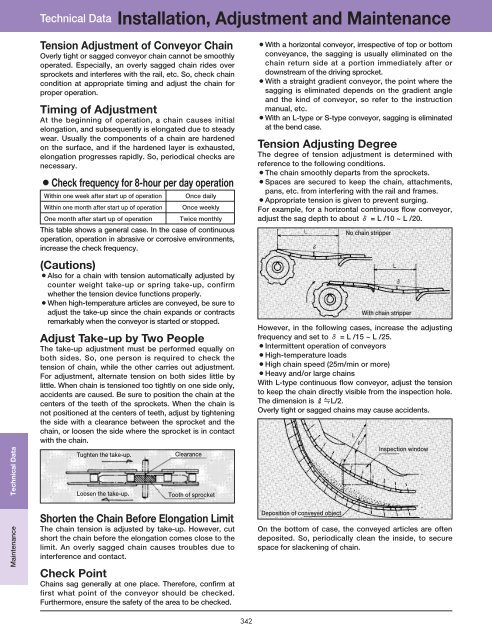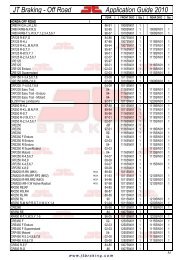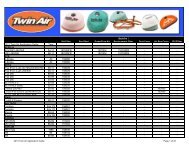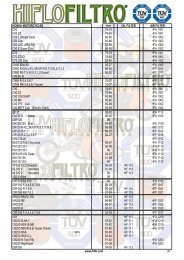DID 60 standard roller chain - Big Bike Webshop
DID 60 standard roller chain - Big Bike Webshop
DID 60 standard roller chain - Big Bike Webshop
Create successful ePaper yourself
Turn your PDF publications into a flip-book with our unique Google optimized e-Paper software.
Technical Data Installation, Adjustment and Maintenance<br />
Technical Data<br />
Tension Adjustment of Conveyor Chain<br />
Overly tight or sagged conveyor <strong>chain</strong> cannot be smoothly<br />
operated. Especially, an overly sagged <strong>chain</strong> rides over<br />
sprockets and interferes with the rail, etc. So, check <strong>chain</strong><br />
condition at appropriate timing and adjust the <strong>chain</strong> for<br />
proper operation.<br />
Timing of Adjustment<br />
At the beginning of operation, a <strong>chain</strong> causes initial<br />
elongation, and subsequently is elongated due to steady<br />
wear. Usually the components of a <strong>chain</strong> are hardened<br />
on the surface, and if the hardened layer is exhausted,<br />
elongation progresses rapidly. So, periodical checks are<br />
necessary.<br />
¡Check frequency for 8-hour per day operation<br />
Within one week after start up of operation<br />
Within one month after start up of operation<br />
One month after start up of operation Twice monthly<br />
This table shows a general case. In the case of continuous<br />
operation, operation in abrasive or corrosive environments,<br />
increase the check frequency.<br />
(Cautions)<br />
¡Also for a <strong>chain</strong> with tension automatically adjusted by<br />
counter weight take-up or spring take-up, confirm<br />
whether the tension device functions properly.<br />
¡When high-temperature articles are conveyed, be sure to<br />
adjust the take-up since the <strong>chain</strong> expands or contracts<br />
remarkably when the conveyor is started or stopped.<br />
Adjust Take-up by Two People<br />
The take-up adjustment must be performed equally on<br />
both sides. So, one person is required to check the<br />
tension of <strong>chain</strong>, while the other carries out adjustment.<br />
For adjustment, alternate tension on both sides little by<br />
little. When <strong>chain</strong> is tensioned too tightly on one side only,<br />
accidents are caused. Be sure to position the <strong>chain</strong> at the<br />
centers of the teeth of the sprockets. When the <strong>chain</strong> is<br />
not positioned at the centers of teeth, adjust by tightening<br />
the side with a clearance between the sprocket and the<br />
<strong>chain</strong>, or loosen the side where the sprocket is in contact<br />
with the <strong>chain</strong>.<br />
Tughten the take-up.<br />
Loosen the take-up.<br />
Once daily<br />
Once weekly<br />
Clearance<br />
Tooth of sprocket<br />
¡With a horizontal conveyor, irrespective of top or bottom<br />
conveyance, the sagging is usually eliminated on the<br />
<strong>chain</strong> return side at a portion immediately after or<br />
downstream of the driving sprocket.<br />
¡With a straight gradient conveyor, the point where the<br />
sagging is eliminated depends on the gradient angle<br />
and the kind of conveyor, so refer to the instruction<br />
manual, etc.<br />
¡With an L-type or S-type conveyor, sagging is eliminated<br />
at the bend case.<br />
Tension Adjusting Degree<br />
The degree of tension adjustment is determined with<br />
reference to the following conditions.<br />
¡The <strong>chain</strong> smoothly departs from the sprockets.<br />
¡Spaces are secured to keep the <strong>chain</strong>, attachments,<br />
pans, etc. from interfering with the rail and frames.<br />
¡Appropriate tension is given to prevent surging.<br />
For example, for a horizontal continuous flow conveyor,<br />
adjust the sag depth to about = L /10 ~ L /20.<br />
No <strong>chain</strong> stripper<br />
With <strong>chain</strong> stripper<br />
However, in the following cases, increase the adjusting<br />
frequency and set to = L /15 ~ L /25.<br />
¡Intermittent operation of conveyors<br />
¡High-temperature loads<br />
¡High <strong>chain</strong> speed (25m/min or more)<br />
¡Heavy and/or large <strong>chain</strong>s<br />
With L-type continuous flow conveyor, adjust the tension<br />
to keep the <strong>chain</strong> directly visible from the inspection hole.<br />
The dimension is RL/2.<br />
Overly tight or sagged <strong>chain</strong>s may cause accidents.<br />
Inspection window<br />
Maintenance<br />
Shorten the Chain Before Elongation Limit<br />
The <strong>chain</strong> tension is adjusted by take-up. However, cut<br />
short the <strong>chain</strong> before the elongation comes close to the<br />
limit. An overly sagged <strong>chain</strong> causes troubles due to<br />
interference and contact.<br />
Check Point<br />
Chains sag generally at one place. Therefore, confirm at<br />
first what point of the conveyor should be checked.<br />
Furthermore, ensure the safety of the area to be checked.<br />
Deposition of conveyed object<br />
On the bottom of case, the conveyed articles are often<br />
deposited. So, periodically clean the inside, to secure<br />
space for slackening of <strong>chain</strong>.<br />
342









